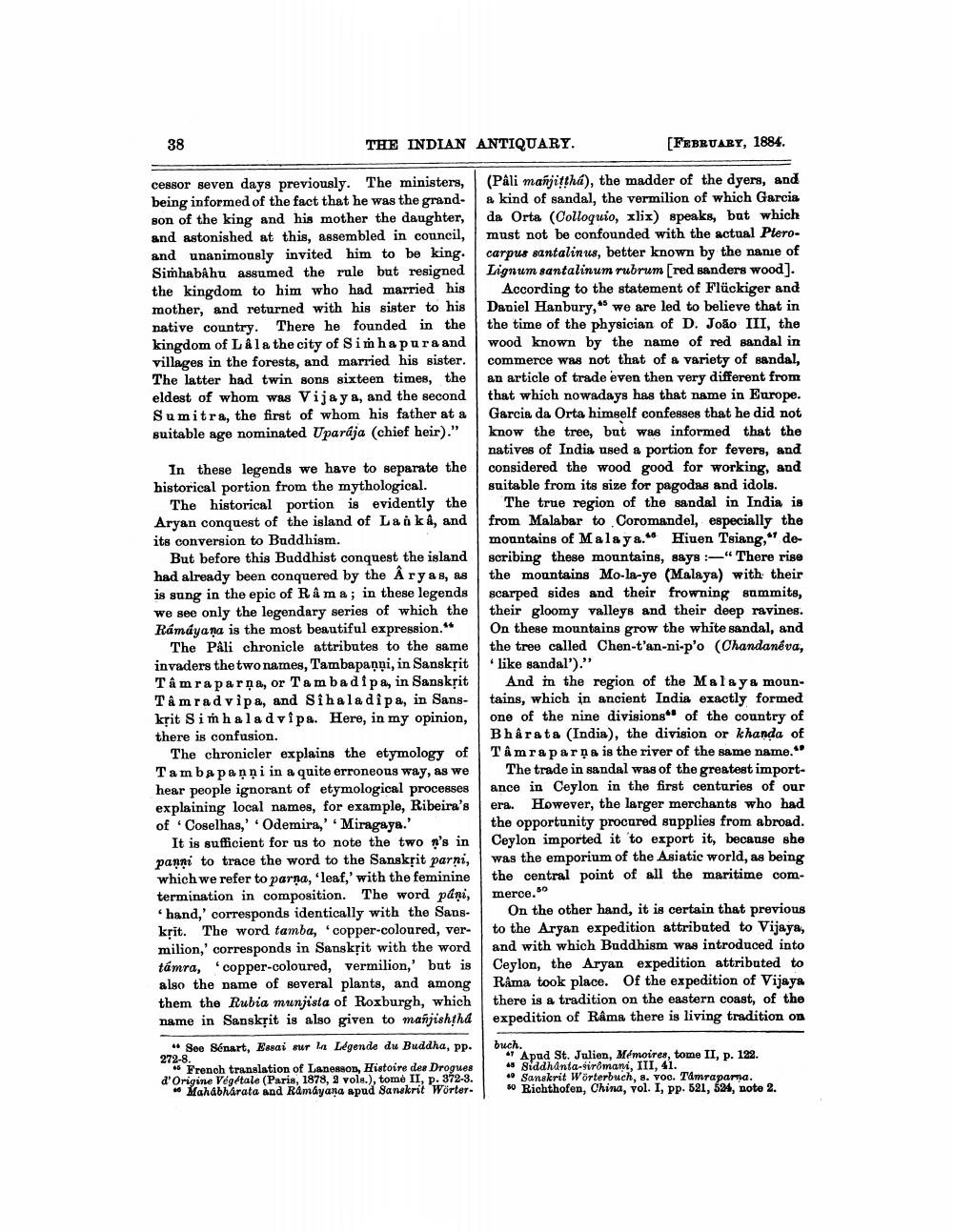________________
38
THE INDIAN ANTIQUARY.
[FEBRUARY, 1884.
cessor seven days previously. The ministers, being informed of the fact that he was the grandson of the king and his mother the daughter, and astonished at this, assembled in council, and unanimously invited him to be king. Simhabahu assumed the rule but resigned the kingdom to him who had married his mother, and returned with his sister to his native country. There he founded in the kingdom of Lala the city of Simhapura and villages in the forests, and married his sister. The latter had twin sons sixteen times, the eldest of whom was Vijaya, and the second Sumitra, the first of whom his father at a suitable age nominated Uparája (chief beir)."
In these legends we have to separate the historical portion from the mythological.
The historical portion is evidently the Aryan conquest of the island of Lai k A, and its conversion to Buddhism.
But before this Buddhist conquest the island had already been conquered by the Aryas, as is sung in the epic of Rama; in these legends we see only the legendary series of which the Rámdyana is the most beautiful expression."
The Pâli chronicle attributes to the same invaders the two names, Tambapaņņi, in Sanskțit Tamraparna, or Tambadipa, in Sansksit Tâmradvipa, and Sihaladipa, in Sanskrit Sinhala dvipa. Here, in my opinion, there is confusion.
The chronicler explains the etymology of Tamba paņņi in a quite erroneous way, as we hear people ignorant of etymological processes explaining local names, for example, Ribeira's of Coselhas,'. Odemira,' Miragaya.'
It is sufficient for us to note the two m's in panni to trace the word to the Sanskrit parni, which we refer to parna, 'leaf,' with the feminine termination in composition. The word pani,
hand,' corresponds identically with the Sans. krit. The word tamba, copper-coloured, ver milion,' corresponds in Sanskrit with the word támra, 'copper-coloured, vermilion, but is also the name of several plants, and among them the Rubia munjisla of Roxburgh, which name in Sanskțit is also given to manjishtha
* See Sénart, Essai sur la Légende du Buddha, pp. 272-8.
* French translation of Lanesson, Histoire des Drogues d'Origine Végétale (Paris, 1878, 2 vols.), tome II, p. 372-3.
Mahabharata and Ramayana apud Sanskrit Wörter
(Pâli manjitthá), the madder of the dyers, and a kind of sandal, the vermilion of which Garcia da Orta (Colloquio, xlix) speaks, but which must not be confounded with the actual Plerocarpus santalinus, better known by the nanie of Lignum santalinum rubrum [red sanders wood).
According to the statement of Flückiger and Daniel Hanbury, we are led to believe that in the time of the physician of D. João III, the wood known by the name of red sandal in commerce was not that of a variety of sandal, an article of trade even then very different from that which nowadays has that name in Europe. Garcia da Orta himself confesses that he did not know the tree, but was informed that the natives of India used a portion for fevers, and considered the wood good for working, and suitable from its size for pagodas and idols.
The true region of the sandal in India is from Malabar to Coromandel, especially the mountains of Malaya. Hiuen Tsiang,'' describing these mountains, says : -" There rise the mountains Mo-la-ye (Malaya) with their scarped sides and their frowning summits, their gloomy valleys and their deep ravines. On these mountains grow the white sandal, and the tree called Chen-t'an-ni-p'o (Chandaneva, like sandal')."
And in the region of the Malaya mountains, which in ancient India exactly formed one of the nine divisions of the country of Bharata (India), the division or khanda of Tamraparņa is the river of the same name."
The trade in sandal was of the greatest importance in Ceylon in the first centuries of our era. However, the larger merchants who had the opportunity procured supplies from abroad. Ceylon imported it to export it, because she was the emporium of the Asiatic world, as being the central point of all the maritime com
merce.
On the other hand, it is certain that previous to the Aryan expedition attributed to Vijaya, and with which Buddhism was introduced into Ceylon, the Aryan expedition attributed to Rama took place. Of the expedition of Vijaya there is a tradition on the eastern coast, of the expedition of Râma there is living tradition on
buch.
Apud St. Julien, Mémoires, tome II, p. 122. 45 Siddhanta-siromani, III, 41. * Sanskrit Wörterbuch, 8. voo. Tamraparna. * Richthofen, China, vol. I, pp. 521, 524, noto 2.




